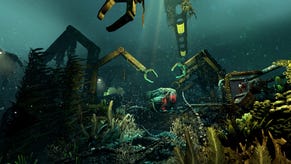The Outer Worlds Armor guide - Armor Rating explained, Light vs Heavy armor
Ah, mi armor...
Armor in The Outer Worlds is one of the most important tools the game supplies you in order to stay alive in the treacherous and dangerous regions of Halcyon, Monarch, and all the other planets you'll hop between throughout your journey. Not only does equipped armor reduce the damage you take against oncoming attacks, but they also give you plenty of scope for customising your character, with many pieces of armor supplying you with extremely useful boosts to certain skills or attributes.
Our The Outer Worlds Armor guide will walk you through how Armor Rating actually works, along with a rundown of how Light Armor compares to Medium and Heavy Armor, and which you might want to take forward depending on your character and playstyle.
The Outer Worlds Armor guide
The Outer Worlds Armor overview
So, why would you bother scavenging every nook and cranny for decent armor like you no doubt do for weapons? Well, there are in fact several reasons for making sure you have good armor equipped on your character (and your Companions). Below is the essential need-to-know info on Armor in The Outer Worlds:
- All characters (including you) have two slots for armor: Chest, and Head. Predictably, Chest slots can only take Chest Armor, and Head slots can only take Helmets.
- The primary reason to equip and upgrade armor is because it gives you increased Armor Rating - the large number in the top-right of the item window. This helps you take less damage.
- Another reason to equip good armor is that many pieces will give you a boost in certain stats, skills, or attributes. For example, the Iconoclast Apostle Armor screenshot below gives my character +5 to my Melee Weapon Skills.
- There are three different types of armor: Light, Medium, and Heavy. Heavy generally provides the best Armor Rating, but Light provides the best skill bonuses.
- As with weapons, all armor pieces have durability that decays when used (i.e. when you are damaged). You can repair armor at a Workbench (for more info on Workbenches check out our dedicated The Outer Worlds Mods & Workbench guide).
- You can also Tinker armor at a Workbench just like weaponry, and you can install mods as well using the Modify function of the Workbench. This is the final reason to equip and maintain decent armor throughout your travels.
As you can see, it's not just about improving your Armor Rating - but we can't deny that Armor Rating is very important. Let's go over exactly how Armor Rating and the amount of damage you take from an attack is calculated.
Armor Rating in The Outer Worlds
From our experimenting and testing, it appears that the way Armor Rating is used to calculate the damage you take is actually very straightforward. The central tenets appear to be these:
- Your Chest Armor and Helmet do not both add to a universal Armor Rating that applies to all damage you take; rather, if your body is damaged then the Chest Armor Rating is used, and if your head is damaged then the Helmet Armor Rating is used.
- Armor Rating is a flat reduction in the damage you take. So if a shot hits you for 175 damage without Armor, the above Iconoclast Apostle Armor would take that shot down to 141 damage.
- However, this does not take into account the Damage Type, which may affect how effective your Armor Rating is in absorbing damage. For more information on Damage Types, check out our The Outer Worlds Weapons guide.
Hopefully (assuming our experimenting led us to the correct conclusion), this will clear up any confusion about how exactly Armor Rating helps you to survive. But the question remains: which is the best Armor type to use?
Light Armor vs Heavy Armor
The different Armor types in The Outer Worlds are a bit of a misnomer; Heavy Armor isn't actually heavier than Light Armor in terms of item weight. Instead, the difference comes generally in the form of Armor Rating.
Armor Rating of course also depends on the item's level, but if you're looking at three pieces of armor of the same level, then the Heavy Armor will provide the highest Armor Rating, followed by Medium, and then Light. However, to balance this out, Light Armor often gives you significant inherent boosts and bonuses to certain skills and attributes, while Heavy Armor often gives none at all. And, as you might imagine, Medium attempts to strike a balance between the two extremes.
It's difficult to look at a piece of Heavy Armor with nearly double the Armor Rating as a piece of Light Armor, and not think it worthwhile to maximise your Armor Rating. But when it comes down to it, you must remember that Armor Rating is a flat reduction, not a percentage-based or algorithmic reduction. Which means it's not as significant as you might think to have that extra 10 Armor Rating. But because of the nature of Skills with their threshold bonuses and so on (if you're unsure about this, just consult our The Outer Worlds Skills guide!), a +10 to a particular Skill might be an extremely worthwhile investment.
And don't forget - you can make up for a deficit in Armor Rating by Tinkering the item using a Workbench. So all in all, it depends on the type of character you wish to play as, along with the enemies you're facing and the difficulty level you're playing at; but I'd urge people to consider a lower Armor Rating in exchange for some powerful skill stat increases.
I realise this might be hypocritical seeing as you can see in the above screenshot my chestplate of choice is a piece of Heavy Armor - but honestly all I can say is that I'm a sucker for increased carrying capacity.
And with that, I'll wrap up this The Outer Worlds Armor guide and walkthrough. I hope this has cleared up any confusion you may have had relating to Armor Rating and armor types during your journeys. And now - why not have a gander at one of our other guides, such as our in-depth look at all the The Outer Worlds perks & flaws on offer?





















